Alaska Fish & Wildlife News
October 2005
Got Moose?
Cows are Key to Altering a Moose Population
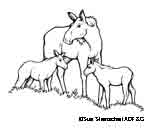
Too many moose eating up all the willows? Shooting cows should help solve your problem. Want to grow a bigger moose population? Don't shoot cows.
Cows are key to increasing or decreasing a population of moose. This is not to say that the bulls aren't important, but let's face it, it only takes one bull to happily service a number of cows.
But oh, the number of moose that one cow can produce. A healthy cow has approximately 15 reproductive years, which means she produces at least ...
Moose Management ArticleContinued
Geoducks: Southeast Gets a Toehold in the Market
World's Largest Burrowing Clam Can Live 140 Years
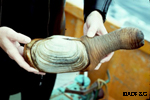
Geoducks are the world's largest burrowing clam. Pronounced “gooey-duck,” they aren't gooey and they aren't ducks. Their name is derived from a Nisqualy Indian term meaning “dig deep.”
There has been a small commercial geoduck fishery in Southeast Alaska since the early 1980s. With the intent to diversify the state economy and highlight Alaska seafood in the world market, the Aquatic Farm Act of 1988 allowed The Alaska Department of Fish and Game (ADF&G) to issue permits for construction ...
Geoducks ArticleContinued
“Fishman and the Bear”
Bring Salmon to Alaska Schools
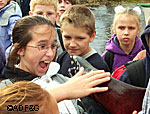
This winter, salmon eggs will be incubating in streams – and classrooms – throughout Southcentral Alaska.
Salmon fry are developing in cold-water aquariums under the watchful eyes of students, thanks to Fritz Kraus. About 100 classrooms are involved in the aquatic education program, sponsored by the Alaska Department of Fish and Game. Known as “Fishman” to thousands of Alaska kids, Kraus has spent 14 years bringing salmon into schools, and bringing students outdoors to salmon streams. His ...
Salmon in Schools ArticleContinued
Counting the Nelchina Caribou Herd
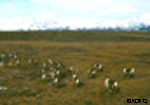
In late May, 2005, the Nelchina caribou herd gathered in the foothills of the Talkeetna Mountains in Interior Alaska. This is the calving grounds and summer range for the Nelchina herd. Thousands of newborn caribou were mixed in with the cows and bulls on the hilltops and ridges overlooking the Susitna River. Wolves are scarce in this area, and calf survival has been high in recent years.
During the month of June, as the weather grew hotter and insects more irritating, the caribou bunched ...
Counting Caribou ArticleContinued
Recipe: Cranberry Venison Stew
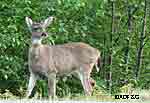
Cranberry Venison Stew
Brown in a large cast iron skillet:
4 tablespoons of unsalted butter
2 tablespoons of olive oil
2 pounds of venison, cubed
Simmer two hours with:
1/2 teaspoon each - salt and pepper
4 to 6 cloves of garlic minced
2 medium onions
1 cup of red wine
2 tablespoons of red wine vinegar
1 tablespoon tomato paste
Add and cook 10 minutes:
combined:
1/3 cup brown sugar
2 tablespoons flour
1 & 1/2 cups ...
Cranberry-Venison ArticleContinued
